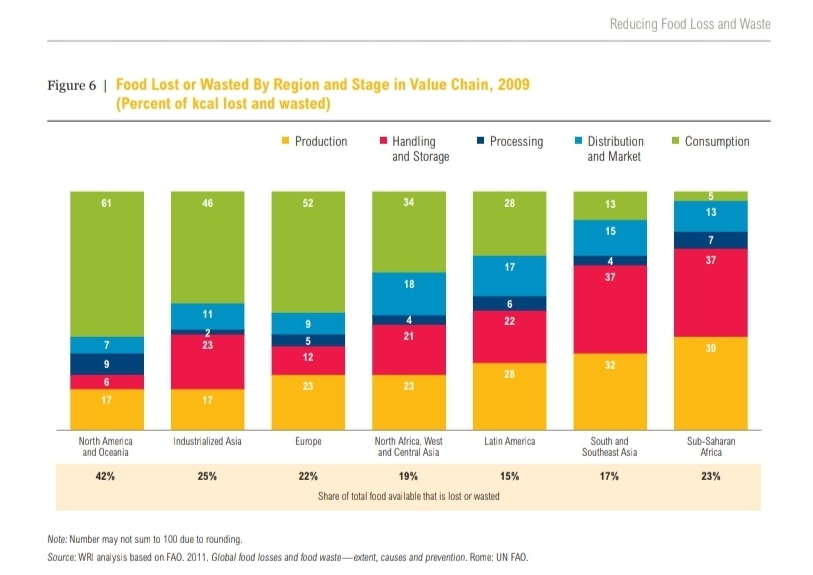Too bad many states will just refuse the money.
It’s the best they can do given the political landscape IMO
That’s probably the reason he is pledging it. It will help democrats in those states.
I don’t get this part…
The full details of the package are expected to be announced by Doug Emhoff, the husband of Vice President Kamala Harris, at an event at the White House later on Tuesday.
Why?! Biden should be doing this! He needs to be out in public looking strong and “doing things”! SMH This makes him look like everybody else is doing his job for him.
Or like at least Harris. She could sure use a win at some point during this presidency. She’s done plenty of work shoveling shit, give her at least one video clip of doing something good. No one’s going to put Doug Emhoff on the news.
… who the fuck cares?
Why doesn’t Biden personally shove his boot up my ass? Him making my boss do it shows how weak he is.
Keep in mind: the largest source of food waste is residential. The second largest source is restaurants.
Food waste is bad for the environment, sure. But the rent being too damn high is a lot more of the reason why people go hungry than me letting a bagged salad in my fridge go bad.
I’d argue that the largest source is actually grocery stores followed by restaurants. I’ve worked a few grocery stores including target when they added pfresh. The food that gets tossed by deli/bakery alone will piss you off. Second harvest would only come around once or twice a week so the rest of the time tons of bread, fried chicken, cakes, etc would get tossed in the trash. And thats not even accounting for the vendor trash. At least once I rescued a ton of little debbie stuff from a dumpster, it was all still boxed up and in date, the boxes had been smashed by something so the vendor tossed it.
The amount of outdated chobani I pulled off an end cap once would make your head spin. I filled up an entire shopping cart once because the idiots who were supposed to be running pfresh just kept stuffing it full without rotating stock or checking dates.
Oh and ask me about the pallets of bananas that tgt would throw out because they were shipped too much, didn’t sell enough, etc.
One bread vendor I knew would take the close dated bread to the nearest good will so it had a chance to sell but I’m not sure about others.
You can argue, sure. But people have actually studied this, and you’re factually just plain wrong.
You’ve seen the centralized waste. But you haven’t picked through a neighborhood’s worth of trash cans to put that centralized waste into the larger decentralized context.
People mistaking anecdotes and feels for data
Can you point to the part in the study that confirms that half of food waste is at an individual residential level?
It’s not that I don’t believe you but this study is absolutely dense and kinda doesn’t have any specific data as far as I can see on that subject but is instead a much wider view in the topic. And FLI number include any post production waste which includes retail, restaurants and consumer level, which means grocery stores and other supply points could be adding to the numbers.
I also don’t love that this references waste of food generates green house gases but states composting as a clean alternative despite it being practically the same process of degradation that leads to emissions of green house gases.
I would love to see cities implement large scale composting programs but that’s just to preserve the biological components for fertilizer instead of mining for artificial phosphates.I notice articles and papers on food waste tend to have not enough data points and a lot of motivated thought points on them. Not enough practical work or solutions. No mention of scaling back production, or local centralized composting (only individual), and adapted policies on food safety.
We just all need to eat more apparently.
Look at figure 2.
Consumption isn’t 50%, but it’s the largest single bar in that chart - significantly so.
Thank you for the figure you were looking at it led me to the original source for that data which is actually even more wild.
So in the North America region it’s actually worse with it being around 61% of food loss occurs at the consumption stage and 42% of food overall is wasted which is INSANELY high and nearly double that of Europe.
Man I guess we really do need to eat more.Consumption stage however does include restaurants and catering, as well as in the home use.
With according to the study the 3 main reasons being
• sorted out for appearance
• not consumed before expired
• cooked but not eatenIt’s speculative to try and guess the amount that is from restaurants and commercial food prep but I would guess the amount thrown out by the cumulative 300+ million Americans each day is probably a good chunk of the percentage if not the majority.
Really interesting study, the one you linked too even steals a couple of their charts. Thanks!
http://pdf.wri.org/reducing_food_loss_and_waste.pdf
Not sure why eating more would be the takeaway. Producing less seems like the way to go considering we already massively overeat.
Looking at the chart you linked my feeling is that the best way to reduce food waste is:
More/tastier/healthier frozen foods.
This will reduce post sales food wastage, as well as wastage at the market.
What I’m getting from this figure is to look at what Latin America is doing. Not only is less food wasted but it’s more evenly wasted across the process. I think that’s a good thing no?
I actually do argue that and I’m not in the mood to tear it apart. I know what the average household throws out despite mine being on the (damn near nothing) end of the bell curve.
If you had actually ever worked any grocery or restaurants, you would know what I know and just because it was done by the nih doesn’t mean it’s accurate at all or even well done.
I really doubt that the entirety of a week’s worth of grocery store trash would be less than that of the combined households that shop there. And as I said because I’m sure the study didn’t cover, thats not even accounting for the various vendors throwing out old or close dated products.
Some things like the aforementioned bread sometimes gets moved elsewhere and I’m sure some of them donate it to second harvest or similar but then you also have the chips, beer, etc that all come in via vendor and the trash/out date stuff goes with them so you can’t really track it because the store doesn’t have that in their system.
I’m also not sure you know how large a standard retail dumpster is and how often they are picked up. You also likely have no idea just how much fits into the compactors that stores use. Stores throw out way way more food than you seem to realize.
In addition to the above, I’d also bet that the nih didn’t account for the “weird” produce that doesn’t make It to shelves because (most) people won’t buy it, if also wager that they didn’t account for the product that goes bad sitting around between suppliers, DCs, stores, etc.
Oh and before I am done here. Please do yourself a favor and look up the definition for the word “argue”. I am not saying that I know for a fact, I’m saying that I would ARGUE that I’m right.
The nih and you are putting this problem on the consumer when just like water usage, the consumer is the least of the problems with waste.
You have a nice day now.
LOL, you’re not entitled to just assume a study is wrong and that your anecdote or gut feeling is better.
Actually I am. That’s kind of how thinking for yourself works. I have years of experience that clearly others don’t. I’ve read enough and seen enough on just how much people throw out and it’s pushed me to reduce my actual trash to a min. For a household of 3 adults we trash way less than people who live by themselves. We compost everything we can, recycle/reuse what we can and burn the rest.
If you or the doofus I responded to had ever actually worked restaurants or grocery stores you would understand what I am saying, but, that would also assume that you have working braincells and aren’t going on just being contrary to argue and feel like you are more than you are.
You have a nice day now.
That’s not thinking.
Anecdotes and feels are not data.
It’s really weird, but common, for people to think it’s actual data, like you’re doing here.
Actually I am. That’s kind of how thinking for yourself works
No, that’s how ignoring facts to fit your personal beliefs work. That’s what Republicans and religious nutters do.
have years of experience that clearly others don’t
Guarantee you the people doing the study have enough experience with grocery store waste to know what they’re talking about. Kinda the point of the study.
If you or the doofus I responded to had ever actually worked restaurants or grocery stores you would understand what I am saying
Im not either of them and I HAVE worked in those places and DO know that you’re wrong. Checkmate.
that would also assume that you have working braincells and aren’t going on just being contrary to argue and feel like you are more than you are
Put this dude in a movie theater cuz that’s some damn fine projection
Ok, I’ll bite.
How many people do you think shopped at your grocery store?
On average, how much food do you think they each wasted per week at home?
How much food per week did your store waste?
How typical do you think these numbers are nationwide?
I work with a massive network of food pantries, some larger some smaller. Every grocery store in our area is engaged with it and we receive massive amounts of day old product. I would guess that either your experience was many years ago, or you just worked for a shitty store.
In Arizona I knew a grocery store that dumped bleach on every outgoing dumpster of food waste to prevent anyone from eating it and offered no such plan to donate it citing costs of labor time to high to justify an employee doing those logistics.
I volunteer twice a week at a pantry and we get sent expired foods often so the supermarkets themselves don’t have to throw it out without getting a tax writeoff for it. They can also hide how much waste they’re responsible for when we have to throw it out. We also get all the produce that had clearly had liquid spilled on it, which usually spoils before we can shelve it.
This right here. We don’t have a food scarcity issue or even a price problem for most things. What we have is a logistics problem. Way too many people live in what are called food deserts. If they have easy access to “food” it’s usually of the convenience store variety, overpriced and extremely bad for you.
I know not everyone can afford it but those that can should look at misfits marketplace. They sell the oddball produce that most people won’t buy so it doesn’t make it your local store, when a design changes drastically or is printed wrong, etc.
Tackiing hunger in this country will take money because money makes thing happen but it will also take more than just buying a bunch of food and handing it out. It’s going to take a push for more community gardens, maybe allowing agriculture inside limits where it isn’t at the moment, etc.
Almost half of food waste is people buying food that they let go bad before they eat it.
That’s substantially a price problem, in that people are more willing to let a cheap banana spoil than a prime rib or lobster. Food being cheap makes people more willing to let it expire.
But fixing residential food waste by making food more expensive would make hunger worse.
I have seen some videos on things like vertical gardens in shipping containers that seem like they would be a great way to bring produce to urban areas that is both fresh, and nearby in terms of logistics.
This looks like a decent article about it from a few years ago on a company in Denver. There are a growing number of companies working on this also, and maybe with some government funds it could spread faster, and in areas most in need first.
This is definitely one of the ways forward. Many, many, many, many moons ago I attempted to run a blog about growing fresh produce in an urban environment. You can’t feed a family on what will fit in a window box or on an apt porch but you can have tomatoes for a salad or on a burger, lettuce for that salad that is actually good for you and more.
If we are talking feeding the most people at once from a central location, hydro and aeroponics is what is needed, combined with leds of varying colors and you can cut the growth time down by 50% or more, that means 90 day tomatoes in 45 or so with aeroponics and 60ish with hydro iirc.
I’m a proponent of multiple avenues. Do the vertical farming and focus on community gardens where kids especially can get their hands dirty and learn something about the planet we live on.
The big problem with advanced (indoor) farming practices is that it defeats the purpose of what makes farming so very cheap…
The sun is providing the power for free. Running lighting for plants will take electricity we aren’t currently collecting from the sun and now adds a cost. Water, soil, and light are all basic ingredients you can get by going for a walk in particularly arable climates. But become controlled variables that need to be heavily paid for in advanced techniques.
It’s not scalable to large scale farming and not using the sun is a huge error in trying to make things more sustainable. Not until mass adopted solar arrays or some kind of passthrough system for light.
All of this is wrong. It sounds like you don’t know how much more efficient hydro and aero is with leds that can be programmed to trick the plants into thinking it’s whatever season you want. Not to mention being able to grow tomatoes in Canada in the winter.
Indoor, vertical farming with aero/hydro is many many times more efficient. The 2 plants I have real numbers for (because they are similar) tomatoes and weed will grow up to twice as fast without manipulating the day/night cycle.
As for energy use. Solar is fucking dirt cheap and even without solar, it’s extremely cheap to run the lights and other systems.
Seriously my dude/dudette. Do yourself a favor and look into this. I highly doubt that everyone who is investing in this and using it now is wrong and you are the only one who knows better. There is a reason why the best weed is always hydro or aero especially when you can grow it anywhere.
You might be surprised to find out just how much produce already comes from indoor farms. It’s the going vertical with it or turning an entire floor of a building into a farm that is what is needed to feed our growing population. You can only spread out so far horizontally, vertically let’s you go as high as you can build.
There’s an inherent geometric problem with using solar for vertical farms. They use the volume of the space, which increases by a cube factor. Solar, however, increases according to surface area, which is a square factor.
You thus quickly hit a limit where you can no longer power the lights for your vertical farm by solar panels you stick on the roof. You have to have either a field of solar panels elsewhere–which might have been used to grow food the old fashioned way–or you have to use something that scales differently. Wind also scales by surface area, so not that. Geothermal or nuclear are maybes.
Possibility one way around this is tweaking the spectrum of lights that plants use. Taking full spectrum sun lighting, converting it to electricity, and then using LEDs to create full spectrum lighting isn’t going to work. However, plants primarily use only a narrow space of blue and red light as part of photosynthesis. This isn’t the full story, either, as plants do use the rest of the spectrum as signals for other biological processes.
Now, do they need the rest of that spectrum all the time and at full power? Depends on the plant. It’s complicated, and we may end up customizing lighting for every crop.
Even then, the square-cube problem will put limits on how big vertical farming facilities can get while being powered by solar and/or wind.
Thank you. I had someone explain this to me before in this kind of directly data driven way but I studied astrophysics and macro-xenobiology so I am not the person to be explaining it back out.
But yeah all that.
It makes me wonder if you could build a vertical farm like a big greenhouse made of glass though and direct light from the sun through the building using reflectors without overheating and cooking the plants but, with green energy production you really get to a point where it’s the fields for growing crops previously are now covered in mined advanced electronics that need replacing and the farming structure itself which isn’t as scalable as just adding a field to your crop rotation.
deleted by creator
This isn’t the problem you two think it is. No one is talking about feeding an entire city from one skyscraper. But, you could feed an entire block from one or two levels of a skyscraper.
I’m now going to block you two twits because I don’t have to time for this shit right now. Going out tonight to see Gladys Knight and I have to respond to someone helping me grow my business.
No I know all about how incredibly efficient hydroponics can be and even deeply loved reading a research paper on using just nutrient enriched water for roots systems without the need for soil. Super cool stuff.
But still doesn’t take into account electricity use is way more power than just using the sun. There is a reason greenhouses are standard still in that they are cheap and only require basic maintenance but still let you harvest the sun as an energy source.
But scaling that to feed an entire country is basically impossible. Power use becomes outrageous and you get limited by size. You need a skyscraper to feed a city and nearly as much energy.
It works on small scale and can be much more efficient than local wild growing for small scale productions but that’s about it.
The math for how much energy we take from the sun and how much of it is absorbed by plants is not negligible. And it will not work for all crops in our current energy needs to run it. Especially with our current production rate and system.
Sorry but it’s the truth. It’s just not there and won’t be for a while.
You really need to argue don’t you?
This problem you are stuck on isn’t actually a problem. Why? Because of how much more efficient it is. No one is saying that one vertical farm will feed the entire country. We will still have local farms, home gardens, etc. This is the future of growing food both produce now and meat in the coming decades.
Yes, the solar panels only convert like 18% of the incoming light, but, again, $ for $ growing things with solar and aero/hydro is way way cheaper than dirt, relying on the sun, seasons, etc.
Seriously. Maybe stop focusing on what you think is wrong and work to improve things.
Vertical farming is the only way we will feed people in the coming decades.
$10 billion funded school lunches for a year during COVID and we should have kept it going. School kitchens are back to having to try to collect “lunch debt” again. So how is less than a fifth of that going to end hunger? This is just election posturing and empty promises. Look for more of these coming soon from the right.
Not American, making a number of assumptions on your system.
This 10 billion funded school lunches for everyone, at a multitude of different places. It was broad, unfocused, to cover something now.
How will this 1.7b be applied? Is it given, is it establishing ongoing sources, long term investment in assets?
Looks like they’re giving it to about a hundred established programs.
Noble cause but they already spent 8 billion 2 years ago and there is plenty of hunger. I’m not sure how another 1.7 billion will fix it.
There is plenty of food but the distribution is a big part of the problem, hopefully they are addressing that.
I mean, his admin is ALSO currently trying to block the Kroger/Albertsons merger, for example. So this is clearly not the only thing going on.
Completely different group within his admin. FTC isnt gonna have a hand in ending hunger
The FTC price increases in foods due to monopolizing is absolutely having a hand in helping to reduce hunger.
Another thing I can think of off the top of my head the Biden admin and democrats are doing is fighting to increase funding for SNAP and resisting republican efforts to impose more restrictions on the program and make it harder to use.
Also the 8 billion isn’t already spent and nothing happened, it’s in the process of being spent and this is more being put on top.
While these are all fine and good, personally I still think a universal basic income would be the best way at reducing hunger. A totally unrestricted program like that though be very hard to push, despite all the evidence of their effectiveness, when there’s fighting over whether or not SNAP should be taking a fine toothed comb to exactly what foods people are or not allowed to buy with it.
While these are all fine and good, personally I still think a universal basic income would be the best way at reducing hunger. A totally unrestricted program like that though be very hard to push, despite all the evidence of their effectiveness, when there’s fighting over whether or not SNAP should be taking a fine toothed comb to exactly what foods people are or not allowed to buy with it.
Conservatives won’t be satisfied until the entire budget for any safety net program is consumed in administrative costs, leaving nothing for the actual people it’s supposed to be helping.
Agree completely on the UBI part!
The government spends hundreds of billions on infrastructure every year.
Have we fixed potholes permanently?
Also, $8 billion is a bit less than $24 bucks per person in America. Do you really think $24 is enough to permanently solve hunger in a country? Do you think that another $5/person is reasonable, a few years later?
I mean, we aren’t all go hungry, obviously.
Can’t wait to see Red States reject the aid for their hungriest constituents.
Oh, a couple of states already did it. Were offered funds to feed kids during the summer time off from school. Rejected for “Socialism”…
Don’t forget the comment about childhood obesity
And those people will still vote Republican to ‘own the libs.’
That’s SOCIALISM! Why not let RICH PEOPLE do that instead? Also I’m VERY VERY happy Elon Musk paid $44BILLION for a website!
… and then destroyed it. The man is clearly a genius.
He’s doing with it exactly what he wanted originally.
Where you think taxes go?
A society built on rich people donating is stupid.
He can pledge whatever he can, but being in control of only the executive branch, his options are limited.
The GOP will NOT LIKE that. ‘Bama and other states will reject the funding because… reasons.
They already are! I don’t see how this will be any different, but I’m all for them figuring out a way to get food to the people that need it. It’s infuriating watching shithole states deny food to theirs in need, especially when it’s being offered at federal expense.
Cruelty, as they say, is the point.
Kellogg’s CEO salivating at all the extra cereal people will be able to buy for dinner.
Hey stop judging me and my dinner choices.
Cornflakes for dinner? Have you not consulted the food reverse funnel? If you don’t eat 4 more loafs of bread you’re starving your body of precious nutrients.
I bet it’ll all go to the illegal migrants, their luxury rooms and their free credit cards. /S
Fuck I hope so whatever helps those trying to get ahead. I work with a lot of immigrants and I’d love to give anyone of them those
Even the venezuelans who have come to beg and destroy the city with crime like they did in my country?😭😭😭
Is this serious? I work with a Venezuelan guy and he’s literally so nice lol
Yes, they brought El city de Aragua to my city. The neighbors are nice though. They just smoke weed and stuffs.
This is the problem. We get told, “Group A is all bad!” Then we see people from Group A living nearby and they aren’t bad.
So we think, “they must be the good ones, the exceptions.”
What we should be thinking is, “why did they lie about Group A? They’re obviously just people who want to live their life.”
Not all of them are good. Thankfully the lowlife and criminal scum went to live in a different district than the one I live in, a district I don’t even have intentions to visit because it was already dangerous before their arrival xd. As long as the bad ones don’t get to my neighborhood, I think it’s alright.
Thankfully the lowlife and criminal scum went to live in a different district than the one I live in, a district I don’t even have intentions to visit because it was already dangerous before their arrival xd.
How do you take the “it was already dangerous” and combine it with the fact that the Venezuelans in your neighborhood are cool, and still come away thinking Venezuelas are ruining your country?
Xenophobia is a powerful force. Don’t let it be. Immigrants are just people, just like all other people. Some commit crime. So do some people everywhere! That doesn’t make immigrants bad.
This is the best summary I could come up with:
The Biden administration has announced a $1.7 billion package to fund initiatives aimed at ending hunger across the U.S. by 2030, the White House announced on Tuesday morning.
The commitment will go towards funding 141 projects across the nation.
The full details of the package are expected to be announced by Doug Emhoff, the husband of Vice President Kamala Harris, at an event at the White House later on Tuesday.
As of 2022, around 17 million households experienced food insecurity nationwide, and more than 44 million people across the U.S. faced hunger, including one in five children, according to the U.S. Department of Agriculture.
The funding builds on the $8 billion already committed to fighting hunger in September 2022.
This is a breaking story.
The original article contains 127 words, the summary contains 124 words. Saved 2%. I’m a bot and I’m open source!
Can we not find a source for the news that isn’t owned by an East Asian religious cult since 2018?
Newsweek is an American publication, owned by American publishing company Newsweek Publishing LLC.
Let me help:
In 2013, IBT Media acquired Newsweek from IAC; the acquisition included the Newsweek brand and its online publication, but did not include The Daily Beast.[11] IBT Media, which also owns the International Business Times, rebranded itself as Newsweek Media Group, and in 2014, relaunched Newsweek in both print and digital form.
In 2018, IBT Media split into two companies, Newsweek Publishing and IBT Media. The split was accomplished one day before the District Attorney of Manhattan indicted Etienne Uzac, the co-owner of IBT Media, on fraud charges.[12][13][14]
Under Newsweek’s current co-owner and CEO, Dev Pragad, it is profitable with revenue of $60 million and also growing: between May 2019 and May 2022, its monthly unique visitors rose from about 30 million to 48 million, according to Comscore. Pragad became CEO in 2016; readership has grown to 100 million readers per month, the highest in its 90-year history.[15][16] The operations of the company were researched by the Harvard Business School; they published a case study in 2021.[17]
https://en.m.wikipedia.org/wiki/Newsweek
Then just check into those companies and the CEO.
I thought there was no money in America to do things like this because excess military surplus was sent to Ukraine?
Seems like a noble cause, why not Trillion?
Because that might actually accomplish something
Oh look the Democrats are trying to get people to vote again
You say that like its a bad thing.
Or do votes only matter when they are for your party?
it’s a good thing. it doesn’t happen enough
Ah, your tone suggests that its a dig rather than a good thing
it’s a dig, because it should be a normal thing and it isn’t












